Economic Affairs, Vol. 64, No. 4, pp. 813-819, December 2019
DOI: 10.30954/0424-2513.4.2019.17
©2019 EA. All rights reserved
Tenant Farming in Punjab: Nature, Pattern and Constraints
Surbhi Bansal* and D.K. Grover
Department of Economics and Sociology, Punjab Agricultural University, Ludhiana-141004, Punjab, India
*Corresponding author: mailto:surbhi.bansal1993@gmail.com(ORCID ID:0000-0003-3780-9850)
Received: 20-06-2019
Revised: 15-10-2019
Accepted: 27-11-2019
ABSTRACT
The paper has demonstrated slow growth rate of agricultural output, escalating input cost, declining profit margin, fragmentation of land, and unemployment are the symptoms of the Punjab’s economy. In such a situation, it become imperative to study how the tenant farmers survive in farming. To keep in mind the above facts, the present study was undertaken to examine the nature of tenancy system and constraints faced by tenant farmers in the state. The study was based on the primary data, collected from 120 farmers, for all the three agro-climatic zones of Punjab pertaining to the crop year 2017-18. Descriptive tools were used to study the nature of tenancy and mean score was used for constraints analysis. The study highlighted that to make them self employed or fulfill the need of family, tenant farmers took land on leased from cultivator who switched to another sector and migrated in large number outside the country. From the study it was perceived that with the increase of size of holding and majority of tenant farmers adopted land holding to improve the scale of farming and to be economically viable.
Highlights
 Expensive farm machinery, ineffective government policies and inadequate timely financial assistance from banks were found as major constraints confronted by the tenant farmers.
Expensive farm machinery, ineffective government policies and inadequate timely financial assistance from banks were found as major constraints confronted by the tenant farmers.
 The legalization of land leasing, transparency in leased contracts, factors affecting the tenant farming is the main policy implications to encourage the tenant farmers in the state.
The legalization of land leasing, transparency in leased contracts, factors affecting the tenant farming is the main policy implications to encourage the tenant farmers in the state.
Keywords: Tenant farming, Nature of tenancy system, Legalization of land leasing, Constraint analysis
Tenancy is one of the oldest agrarian institutional devices evolved in order to make the distribution of operational holdings more equitable than the distribution of ownership holdings and contributes to a better distribution of income than would be possible without it (Srivastava 1983). Thus the promotional role of tenancy as an institution has an important bearing upon the distribution of land ownership. Contrary, the distribution of land ownership not only determines the concentration of land holdings in the rural economy but also shapes the tenancy structure. The traditional view of tenancy market holds the view that the small farmers, in general, intend to leased-in land, while the large farmers are involved in leased-out operation. This temporary transfer of land via tenancy is evolved to facilitate adjustment and interlinked transactions in agriculture (Bardhan and Rudra 1978). The tenancy is seen as a source of exploitation of the tenant and thus some proponents of the thought leveled it as a semi-feudal institution which retards technological innovation in agriculture (Bhaduri, 1973; Bharadwaj, 1974; Prasad, 1974). Being inelastic in supply and immobile in nature it assumes greater importance among the farming community with an increasing demand for it. Main factors which affect the demand for land are population, urbanization and productivity. It is, however, felt that owing to enforcement of various land laws, high cost of farm technology, exorbitant land prices, etc. the land market has somewhat frozen (Chadha and Baumik 1992). In fact the efficiency of tenant farming is a critical issue in many developing countries by problems of asymmetric information and limited development of credit markets.
How to cite this article: Bansal, S. and Grover, D.K. (2019). Tenant farming in Punjab: nature, pattern and constraints. Economic Affairs,64(4): 813-819.
In a growing economy, there are always some people who switch on to non-farm activities, migrate to urban areas or are unable to cultivate their land themselves, all of whom are willing to leased-out land. The main reasons of leasing in land among tenant farmers are joining service or emigration to other countries by the farmers. The laws and by laws governing the distribution and tenancy of land have become obsolete and redundant against the forces of demand and supply, which need to be made more pragmatic in a dynamic society (Singh et al., 2004).
In Punjab, leasing of agriculture land is not banned, but the tenant acquires the right to purchase the leased land after a specific period of tenancy (this is generally six years). As a result, the tenancy laws in the state are restrictive and discourage recording of the tenancy. As a result, tenancy of land is generally informal. Various studies of proportion of operated area leased, conducted by the National Sample Survey Organization (NSSO), have shown how the percentage share of leased-in land has declined. From 39.8 per cent leased-in area in 1953-54, the proportion has declined to 24.42 per cent in 2012-13. Though the percentage has seen an increased from 17.84 per cent in 2002-03 survey to 24.42 per cent now, it is mainly because of more farmers leaving agriculture for other means of livelihood (GOI 2014). In such a situation, an increase in the cost of production, falling returns and increasing uncertainty on account of erratic weather condition It becomes imperative to study how the tenant farmers, especially, survive in farming. To keep in mind, the present study was proposed to study the nature of tenancy system and constraints faced by tenant farmers in the study. The objective of study was:
♦To study the profile of tenant farmers in Punjab
♦To study the nature of tenancy system in Punjab.
♦To find out various constraints faced by the tenant farmers in Punjab.
♦To formulate the policy implications regarding tenant farming in Punjab.
Data and Methodology
The primary data at farmers’ field were collected from three agro- climatic zones of Punjab through multistage random sampling technique during the crop year 2017-18. At the first stage, one district was selected randomly from each zone. At the second stage, two blocks from each of the selected district was taken randomly. At the third stage, two clusters (2-4 villages) from each block were randomly chosen. At the final stage, 10 tenant farmers was randomly chosen from each cluster and making 120 in all for the ultimate survey. The operational definition of tenant farmers refers to those farmers whose lease¬in land was more than that of his owned land. In order to study in depth, tenant farmer had been divided into two group on basis of their leased-in land (i) low intensity tenant (whose leased-in land was (50-75) than that of operational holding) and (ii) high intensity tenant (whose leased-in land was (≥75) than that of operational holding).
Analytical Tools
Descriptive statistical tools such as averages, percentages were used. Dependency ratio was also used in analysis. For constraint analysis, a score of -1 for disagree, 0 for neutral and 1 for agree were used to the identify the problems and depending upon the responses, mean score were calculated for all the constraints, so as to rank them accordingly.
RESULTS AND DISCUSSION
The results were discussed under sub-heads (i) profile of tenant farmers in Punjab, (ii) nature of tenancy system, (iii) constraint faced by tenant farmers and (iv) policy implications.
(I) Profile of tenant farmer in Punjab
This part is mainly devoted for the study of the profile of selected sampled tenant farmers in Punjab. The important characteristics of profile chosen for analysis are age of family head’s, education level, experience in farming, composition of family and ownership of land holding. From Table 1, it was observed that out of 120 sampled tenant farmers, the majority of family heads’ belong to 30-50 age groups; their average was 43.23 years. The education of tenant farmers was ranged between upper¬primary to to matric level. The average schooling years were quite homogenous in tenant as well as group of tenant farmers i.e. 9 years. The forgoing analysis of family composition indicated that males were dominated over females in tenant farmers. According to population census of 2011, the sex ratio of Punjab was 895 females per 1000 of males which were below as compared to India sex ratio i.e. 943 per 1000 of males (Anonymous 2017). The sex wise composition was markedly higher 1:0.66 in group II tenant farmers than that observed in 1:0.64 in tenant farmers. The dependency ratio was observed higher i.e. 45.67 in case of group I tenant farmers, followed by 38.71 in case of tenant farmers and 35.02 in case of group II tenant farmers.
Table 1: Profile of sampled tenant farmers in Punjab, 2017-18 (Number)
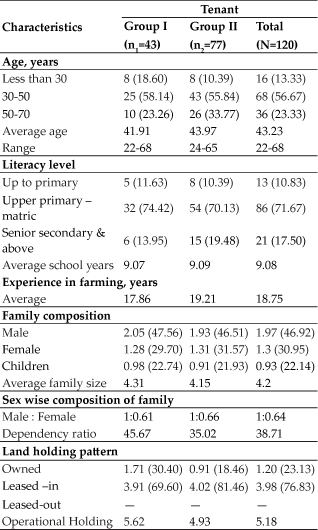
Figures in bracket depict percentage of total sample size.
Thus, the study concluded that number of people below 15 years age group and those above 64 years were recorded more in tenant farmers as compared to number of people (15-64) age group. Land is considered as the most important assets owned by the farmer. It is well known fact that operational efficiency of the farm varies with farm size and an adequate farm size yield better returns. In this respect, farmers do all efforts to expand their operational farm holdings which in turn increase the farm productivity by efficient utilization of farm resources. The farmers can increase the operational land holdings either by purchasing agricultural land or leasing-in land. The proportion of operation holding in the groups of tenant as well as tenant farmers in states was observed to be higher as compared to average operational holding of Punjab state i.e. 3.77 ha (Anonymous, 2017). The average operational holding of tenant farmers was observed 5.18 ha in study area. It might due to tenant farmers included the owned land and leased in land to make operational holding economical viable.
(II) Nature of tenancy system in Punjab
The structure of land leasing is an important component of Punjab agriculture. The tenancy system has made possible the access of the fallow resulted in to sustain their livelihood from farming sector as well as better utilization of available resources and increasing farm output. The pattern of leasing land, nature of the legal agreements of tenancy system, rental value, reasons for land leasing are studied in this section.
Table 2: Pattern of leased-in land of sampled tenant respondents of Punjab, 2017-18
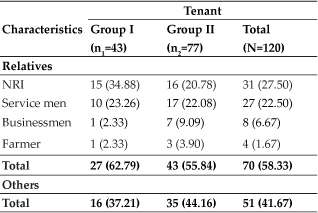
Figures in bracket depict percentage of total sample size.
The pattern of land leased-in is represented in Table 2 revealed that most of tenant farmers took land on leased from their relative i.e. 58.33 percent as compared to other than relatives. Among the relatives, the proportion of area under leased in taken from NRI (who left farming due to settle in abroad), was 27.50 percent, followed by 22.50 percent in case of service men and 6.67 percent in case of businessmen (who moved out in other sector than agriculture). A very small proportion i.e. 1.67 percent of total sample size was observed in case of farmers.
Nature of tenancy agreement
The tenancy contract (nature of tenancy agreements, payment schedule and rental value of per ha land) by such landless or marginal/small farmers with their landlords was discussed in table 3.
Table 3: Nature of agreements among sampled tenant respondents of Punjab, 2017-18 (Number)
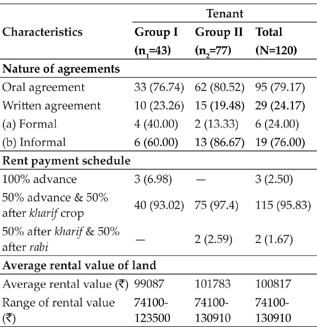
Figures in bracket depict percentage of total sample size.
It depicted oral agreement was common features of tenancy system among sampled tenant farmers spread in Punjab as compared to written agreements. The analysis of table revealed that nearly 2/3 of sample respondents did oral agreement or informal agreement for credit service and only 1/3 of respondents were accessed written agreement or formal agreement for leased-in land. The proportion of the farmers making tenancy an oral agreement came out to be 76.74, 80.52 and 79.17 per cent in group I, group II and total tenant respectively. While only 21 percent people accessed informal written agreements In written agreements, farmers 76 percent preferred informal written agreements and only 24 percent do legal or formal agreements. It implied there was no legal restriction or fixation while making land leasing (GOI, 2016). In nutshell, we can say that oral types of agreement were mostly prevailed in Punjab state. Legal restriction on land leasing considered as safe guard of providing security to the tenant on account of fixation of terms, conditions like fair rent, time period of leasing tenure etc. Due to legal restriction, no land owner ejects the tenant farmers except on certain specified grounds. This was reason landowner preferred to give land on informal basis (Haque 2012).
The payment schedule revealed that most of tenant farmers only preferred “50% advance & 50% after Kharif crop” i.e. 95.83 percent of total sample size and 2.50 for “100% advance” and 1.67 percent for “50% after kharif & 50% after rabi”. The other two type of payment schedule preferred by tenant farmers when (1) farmers get relaxation of interest amount (2) farmers were forced to pay rental value of leased-in land for acquiring land (3) Urgency social as well as economical need of landowner. The average rental value of leased-in land recorded more in group II i.e. high intensity tenant farmers ₹ 101783 as compared to ₹ 100817 in tenant farmers. It implied that more the land on leased lead more rent was paid for leased-in land. The range of average rental value varies from ₹ 74100-130910 in case of tenant farmers.
Reasons for land leasing-in land
The structure of land leasing has been observed to be changed during the last few decades due to many reasons. An attempt has been made to find out the various reasons with regard to leased-in agricultural land among the tenant as well as groups of tenant farmers. The result in this regard was presented in Table 4. The analysis of study revealed that most of farmers respond “source of employment” was the main reason for leased-in land. They were forced to adopt agricultural occupation for making themselves employed due to lack of non-farming employment opportunities leads to leave this profession under the circumstance of assured job opportunities in other sector (Singh, 2017). As perceived by the farmers, the mean score of reasons calculated as per the response of tenant farmers in term of (agree=(1), disagree=(-1) and neutral=(0)) considered creation of self employment was cause of leasing agricultural land on high rent . The other reason was with 0.73 mean score for land left by relatives and friends, 0.53 mean score for underutilized farm resources, 0.41 mean score for scale of farming (increase the size of operational holding by leased more land) and 0.38 mean score for lower rental value. In nutshell, the tenant farmers tried to consolidate land on rental basis on account of making their agriculture operational holding efficient due to two most important reasons; firstly due to make themselves self-employed and secondly to enhance the utilization of excessive farm resource.
Table 4: Reasons for leased-in land among sampled tenant farmers in Punjab, 2017-18 (Mean score)
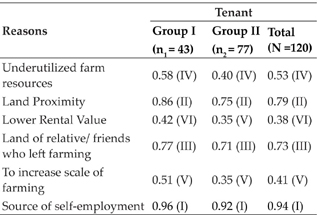
Source: Figures in bracket indicate rank calculated based on their mean score.
(III) To find out various constraints faced by the tenant farmers in Punjab
For clear picture of constraints faced by tenant farmers, constraints were categorized into three parts (1) technology related constraints, (2) land related constraints and (3) institutional related constraints.
Technology related constraints
The adoption of new technology in agriculture is core of agricultural growth, ensuring sustainable development, enhancing agricultural productivity etc. Table 5 analyzed that improved technology i.e. technical skill, human capital, machinery and high yielding inputs for cultivation was found to be costly or more expensive by tenant farmers. It might be due to duration of lease one year, high rent value, disputes with landlord leads tenant farmers not to use new technology on other’s land. In study, most of tenant farmers found adopting new technology on leased-in land was too expensive with 0.95 mean score. It was due to lack of financial facilities like credit, insurance as well as unavailability of minimum rate of interest loan on leased in land. The other constraints were unavailability of machinery, small size of holding and non-availability timely technical guidance for adopting new machinery provided to farmers for guiding optimizing use of resources available which adversely affect the tenant farmers.
Table 5: Constraints faced by sampled tenant farmers in Punjab, 2017-18
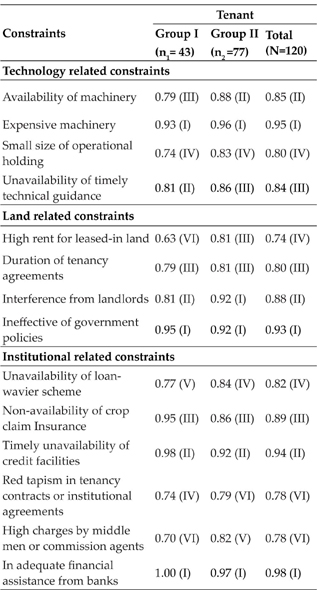
Source: Figures in bracket indicate rank calculated based on their mean score.
Land related constraints
Land is considered as the main important assets owned by farmers. There were various constraint faced by tenant farmers for accessing leased in land i.e. fluctuating market rate of rent and timely availability of inputs. It depict that most of tenant farmers responded for ineffective government policies with 0.93 mean score. The other severe problem faced by tenant farmers was rent payments, duration of tenancy agreements and inference from landlord. In nutshell, the government has proposed model on land leasing at India level in 2015 and the Punjab land leasing and tenancy bill in 2019 to protect the rights of cultivators and land owner, fast solution of disputes, enhancing cooperation among them and also ensure tenant farmers to have access to institutional credit without affecting the landowner’s title rights.
Institutional related constraints
Institutional constraints like insurance, credit facilities, help from governments, financial loan from public sector has been faced by tenant farmers in study area. The foremost institutional constraint was responded by tenant farmers were unavailability of credit facilities in study area. It might due to lack of recognisation and official records of tenant farmers regarding lease-in land by government, most of owner farmers preferred oral agreement as compared to written agreement or formal agreement due to legal restrictions. This discrimination against tenant farmers was due to their inability to offer land collateral as security. This compel most of tenant farmers to approach to approach informal agencies like arhtias, money lender or land lord for the fund, leaving the tenants at the mercy of these money lenders. As the absence of transparency in tie-ups with land lords makers them pay exorbitant and unreasonable payouts in cash and kind. They had limited access for subsidized seed, fertilizers, credit facilities sponsored by government problems like crop claim insurance, middle men influence, and public institution for providing loan. In order to overcome this constraint, Punjab government had made a Punjab land leasing and tenancy bill Act in 2019 for betterment of farmers in order to provide insurance facilities, credit and loan on lease in land by providing written agreement (Anonymous 2019).
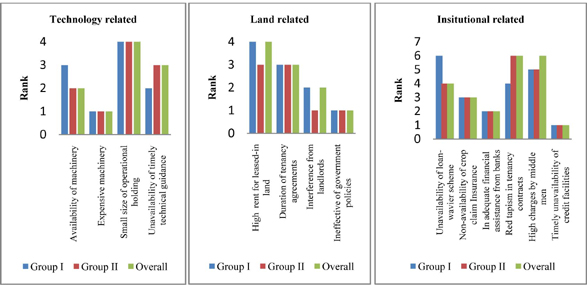
Fig. 1: Constraints faced by sampled tenant farmers in Punjab, 2017-18
(IV) Policy implications regarding tenant farming in Punjab
Based on the observations and statistically proven evidences along with the suggestions from the respondents, some of the policy recommendations are:
♦If an owner, out of lack of interest, lack of money to invest or other reasons, does not want to cultivate the land, they can choose to lease it out to some landless cultivator and benefit from the rent rather than keeping the land fallow. Tenant farmers who try to eke out a living from growing crops on someone else’s land, will get employment and income, so its win-win situation for both the parties. Therefore, there is need of suitable policy measures to encourage area under leased-in.
♦The study brought that the dependency ratio was observed more in tenant farmers with low experience in farming and education level.Thus, in the interest of farmer, suitable policies measures may be framed to encourage tenant farming in order to provide livelihood.
♦A large numbers of factors (pattern of land leasing, nature of tenancy agreement and rental value of land) were found to affect the tenant farming in the Punjab. Therefore, there is need to make suitable polices in this context to safeguard the interest of tenant farmers in farming.
♦From the policy point of view, introduction of transparent land leasing contracts should be aimed at not only allowing the landowner to enter into a written contract with the potential tenant but also at incentivizing the tenant to make long term investments in improvement of land and get access to credit and subsidies.
♦The Punjab land leasing and tenancy bill 2019, if applied effectively at ground level, will not only help to increase the income and productivity of tenant farmers’ land significantly, it will also help overall agricultural growth while helping the government double farmers’ income.
♦Of all the constraints, expensive farm machinery, ineffective government policies and inadequate timely financial assistance from banks were confronted major constraints by the tenant farmers in the state. Hence government should initiate policy or act to support tenant farmers.
CONCLUSION
The paper has demonstrated the pattern of tenant farming in Punjab. The study concluded that the dependency ratio was observed more in tenant farmers which was reason to lease the land for fulfilled the requirements of family members. Moreover, the size of holding was gradually declining and an overwhelming majority of holdings have become marginal and economically non-viable. Due to the small land base and lack of local employment opportunities cultivators were moving out of agriculture and migrating in large numbers outside. The paper suggests various policy implications of problems/ constraints faced by tenant farmers in most agricultural developed state of India, where most of farm population of country lives. The state should (1) increase access to land by all categories of farmers and make agricultural holding more viable, (2) permitted long duration contracts to encourage productivity and investment (3) overcoming the problem of fragmented holding without formal consolidation (4) tenancy agreement should be written stipulating the rent amount, the length and other important term of leased.
REFERENCES
Anonymous. 2017. Statistical Abstract of Punjab. Economic and Statistical Organization of Punjab, Chandigarh.
Anonymous. 2019. The Punjab land leasing and tenancy bill, retrieved http://plrs.org.in/pdfs/For%20Print_Version%202_Punjab%20Tenancy%20Bill,%20%20 2019. pd
Bardhan, P. and Rudra, A. 1978. Interlinkage of land, labour and credit relations: An analysis of village survey data in East India. Econ. Pol. Wkly., pp. 367-384.
Bhaduri, A. 1973. A study in agricultural backwardness under semi-feudalism. The Econ. J., 83(329): 120-137.
Bhardwaj, K. 1974. Production conditions in India agriculture: a study based in farm management surveys, Cambridge University press, Cambridge.
Chadha, G.K. and Bhaumik, S.K. 1992. Changing tenancy relations in West Bengal: Popular notions, grassroot realities. Econ. Pol. Wkly., pp. 1089-1098.
GOI. 2014. NSSO 70th Round on Key Indicators of Land and Livestock Holdings in India, New Delhi.
GOI. 2016. Report of the expert committee on land leasing. Niti Aayog, New Delhi.
Haque T. 2012. Agricultural Tenancy Reforms in India in Land Policies for Inclusive Growth, edited by T. Haque, Concept Publication Company, New Delhi.
Parsad, P.H. 1974. Reactionary role if usurer’s capital in rural India. Econ. Pol. Wkly., 9 : 1305-1308.
Singh, B., Garg, B.R. and Singh, J. 2004. Growth in productivity, land rent and land prices: A Post Revolution Analysis of Punjab Agriculture. Agric. Situ. Ind., pp. 91-97.
Singh, G. 2017. Agricultural land lease market in Punjab. M.Sc. Thesis, Punjab Agricultural University, Ludhiana, India.
Srivastava, R. 1989. Tenancy contracts during transition: A study based on fieldwork in Uttar Pradesh (India). J of Peasant Studies, 16(3): 339-395.
 Expensive farm machinery, ineffective government policies and inadequate timely financial assistance from banks were found as major constraints confronted by the tenant farmers.
Expensive farm machinery, ineffective government policies and inadequate timely financial assistance from banks were found as major constraints confronted by the tenant farmers. The legalization of land leasing, transparency in leased contracts, factors affecting the tenant farming is the main policy implications to encourage the tenant farmers in the state.
The legalization of land leasing, transparency in leased contracts, factors affecting the tenant farming is the main policy implications to encourage the tenant farmers in the state.




